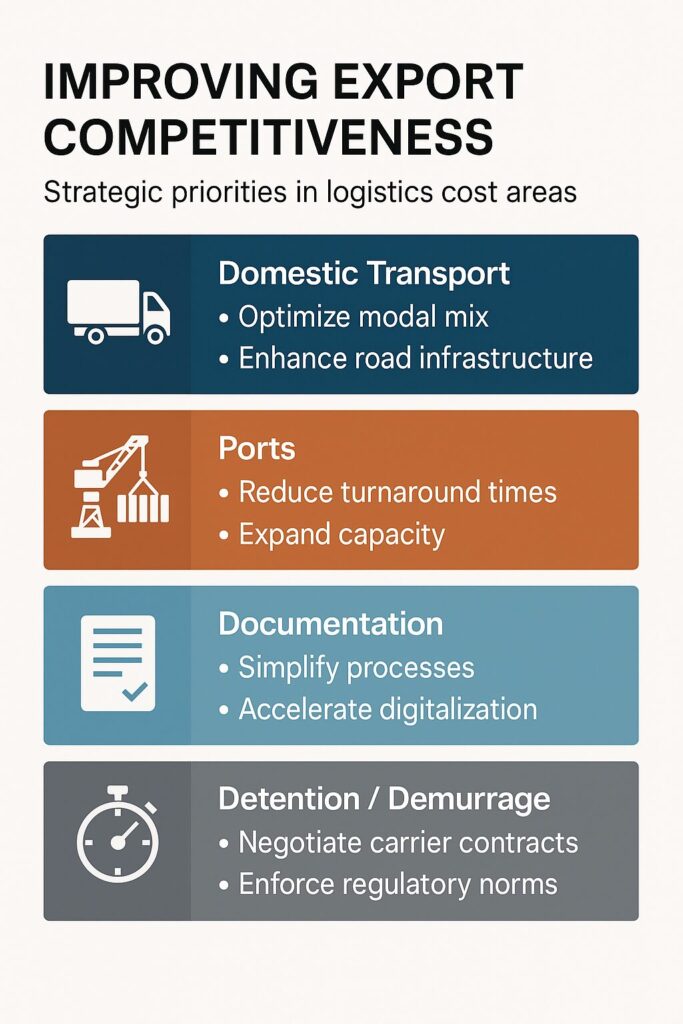National Logistics Policy: Implications for India’s Export Competitiveness
By Amulya Charan / October 2025
Executive summary
India’s National Logistics Policy (NLP)—launched on 17 September 2022 and tightly coupled with PM Gati Shakti (National Master Plan for multimodal connectivity)—aims to make supply chains faster, cheaper, greener, and more predictable, thereby lifting India’s global export competitiveness. The policy’s “soft infrastructure” reforms (digital platforms, regulatory simplification, service-quality mechanisms, skills) complement “hard infrastructure” programs (expressways, freight rail corridors, port modernisation, inland waterways), with an explicit goal to bring India’s logistics costs down to global benchmarks by 2030 and improve India’s standing in the World Bank Logistics Performance Index (LPI). lpi.worldbank.org+3Press Information Bureau+3pmgatishakti.gov.in+3
Two recent developments underscore both progress and potential:
- The Government’s new logistics-cost framework (DPIIT/NCAER methodology) estimates India’s total logistics cost at ~7.97% of GDP in FY2023-24, substantially below legacy estimates often quoted at 13–14%. If sustained and broadened, this realignment would be transformative for exporters’ landed-cost competitiveness. master-dpiit.digifootprint.gov.in+2ETInfra.com+2
- India’s LPI 2023 ranking stands at 38th globally, with strong improvements in international shipments speed and infrastructure quality—momentum the NLP is designed to accelerate. lpi.worldbank.org+1
In parallel, ULIP (Unified Logistics Interface Platform) is knitting together dozens of government systems via APIs to provide shipment visibility and data access to industry, while E-LogS (Ease of Logistics Services) offers a formal, digital channel to flag and resolve logistics frictions—both crucial for reliability and exporter confidence. Press Information Bureau+2Press Information Bureau+2
The bottom line for exporters: lower and more predictable logistics costs, faster door-to-port and port-to-market lead times, and fewer compliance frictions directly improve landed prices, inventory turns, and on-time delivery performance—three pillars of export competitiveness.
1) Why logistics is central to export competitiveness
Export performance depends on a few hard metrics:
- Landed cost (FOB/EXW price + domestic logistics + international freight + border costs)
- Lead-time & reliability (variance is as critical as the mean)
- Service flexibility (ability to pivot modes/routes during disruptions)
- Working capital (inventory and receivables days driven by transit & clearance time)
India’s logistics historically leaned road-heavy, with multimodal integration, digital visibility, and urban freight efficiency lagging. NLP’s integrated approach tackles all four.
2) The architecture: NLP + PM Gati Shakti (hard + soft infrastructure)
PM Gati Shakti (2021) is the geospatial, planning, and execution backbone for multimodal connectivity across 16 ministries—expressways, rail freight corridors, ports, airports, logistics parks, and economic zones—so assets are co-planned and co-sequenced (not siloed). NLP layers on top to align policies, standards, data, and service quality. pmgatishakti.gov.in+1
Key NLP instruments exporters should care about:
- ULIP (Unified Logistics Interface Platform) – API-based access to data from 39+ systems across 11 ministries (125+ APIs), enabling shipment visibility, document digitisation, and analytics for route/mode optimisation. Early uptake has seen hundreds of companies integrate, with tens of millions of API calls—evidence of utility for trade. Press Information Bureau+1
- E-LogS – A structured B2G channel for escalating and resolving logistics issues; 35+ associations onboarded and issues resolved across policy and operations, signalling a maturing service-quality loop. Press Information Bureau+1
- LEADS (Logistics Ease Across Different States) – Annual benchmarking of states’ logistics ecosystems, rewarding reforms and identifying bottlenecks that matter for export manufacturing hubs and gateways. Recent editions show “Achiever” states like Gujarat, Karnataka, Maharashtra, Tamil Nadu and others driving process improvements that exporters can leverage. Press Information Bureau+2The Economic Times+2
- City Logistics Plans (CLPs) – Guidelines rolled out under NLP to decongest urban freight, cut emissions, and improve last-mile reliability—critical for getting export cargo from factory to port/airport on time. Press Information Bureau
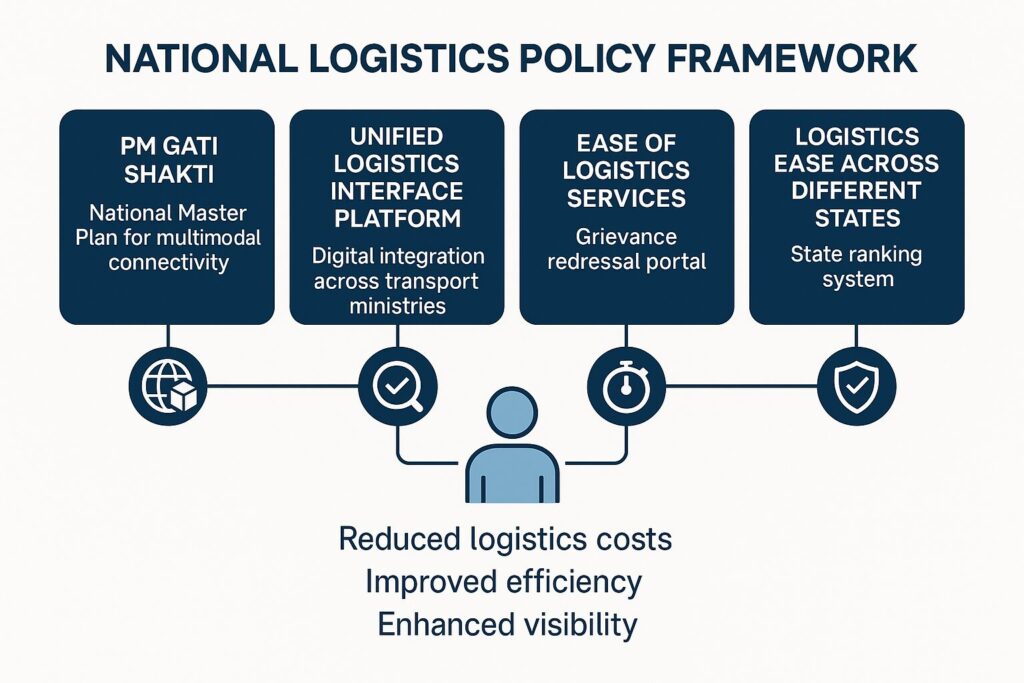
3) Hard infrastructure momentum that exporters can feel
a) Highways and economic corridors
A sustained build-out of greenfield expressways and corridor upgrades under Bharatmala and allied programs aim to compress road transit times and lower vehicle operating costs—especially valuable for high-value, time-sensitive exports. Policymakers continue to signal a target of single-digit logistics costs, with ongoing expressway commissioning. The Times of India+1
b) Rail: Dedicated Freight Corridors (DFC)
The Western and Eastern DFCs are steadily ramping operations, with a sharp rise in train trips and operational capacity. Dedicated paths, higher axle loads, and terminals along corridors improve speed, reliability, and predictability, with spillovers to passenger lines by decongestion. Independent analyses attribute lower freight costs and time to DFC commissioning, translating into modest but widespread commodity price reductions—benefits that accrue to exporters through lower inland haulage and inventory days. The Economic Times+2DFCCIL+2
c) Ports & coastal/inland water transport
Under Sagarmala, India has advanced port capacity, ship turnaround, and container dwell time performance. FY2014–FY2024 saw ship turnaround time at major ports fall from ~94 hours to ~48 hours, and container dwell time to ~2.6 days; capacity additions exceeding 500+ MTPA have been reported through completed modernisation projects. These improvements trim ocean-side uncertainties and cut export cycle times. Deccan Chronicle+1
Ports like JNPA have recorded measurable gains in the World Bank/S&P performance metrics and local dwell times (import dwell near a day at points in 2025), improving the schedule reliability exporters require for just-in-time shipping windows. India Shipping News+1
d) Air cargo and time-sensitive exports
While not an NLP-specific asset class, air-cargo terminals benefit from the same digital single-window thrust (ULIP/ICEGATE linkages), which shrink documentation touchpoints and help pharma, electronics, and perishables exporters hit delivery SLAs. (General LPI improvements capture some of this effect.) lpi.worldbank.org
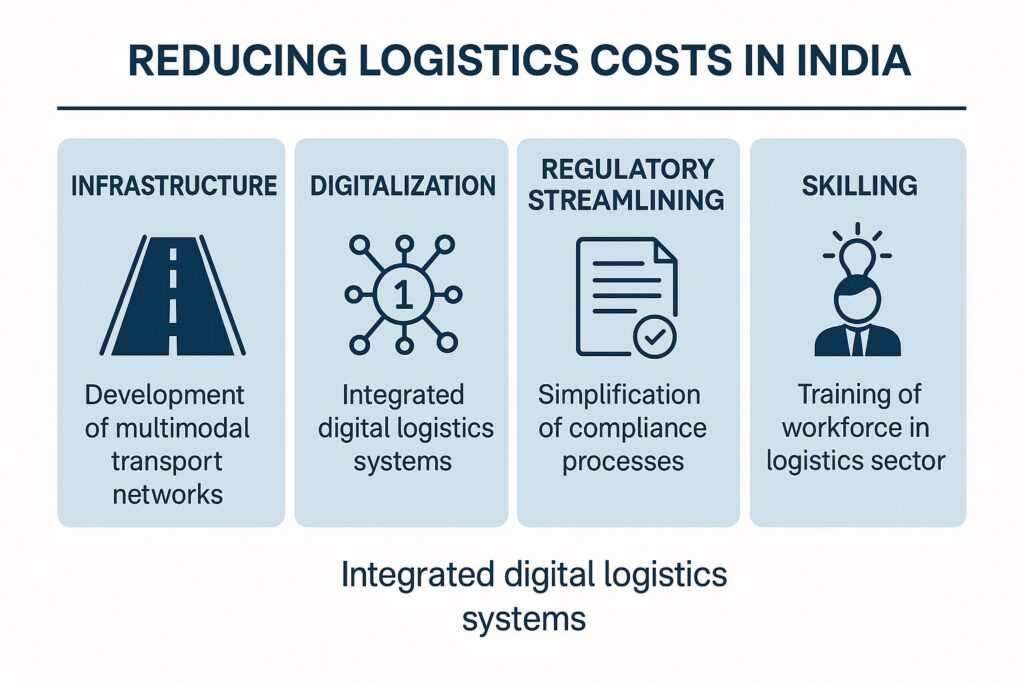
4) The cost story: from debate to measurement—and competitive impact
For years, India’s logistics cost was assumed to be ~13–14% of GDP. DPIIT’s new bottom-up methodology (2025) puts the FY2023-24 figure near 7.97% of GDP (and ~9.09% of non-services output). Even if sectoral realities vary (by product, corridor, and firm size), the new baseline matters because what gets measured gets managed. Exporters should expect:
- Sharper policy targeting (corridor-/commodity-specific pain points)
- Data-linked incentives (e.g., for multimodal shifts or digital adoption)
- Investor confidence in freight/warehouse assets based on credible cost curves
Ministerial guidance has also reiterated a single-digit cost ambition, which, if matched by consistent execution, materially raises margins or headroom for price competition in world markets. master-dpiit.digifootprint.gov.in+2The Economic Times+2
Implication for exporters: At a firm level, every 1 percentage-point drop in logistics cost (as share of ex-factory value) can lift price competitiveness (or margins) for undifferentiated products and free working capital by cutting in-transit inventory. In differentiated goods, improved reliability can tighten promised delivery windows—key for winning repeat orders.
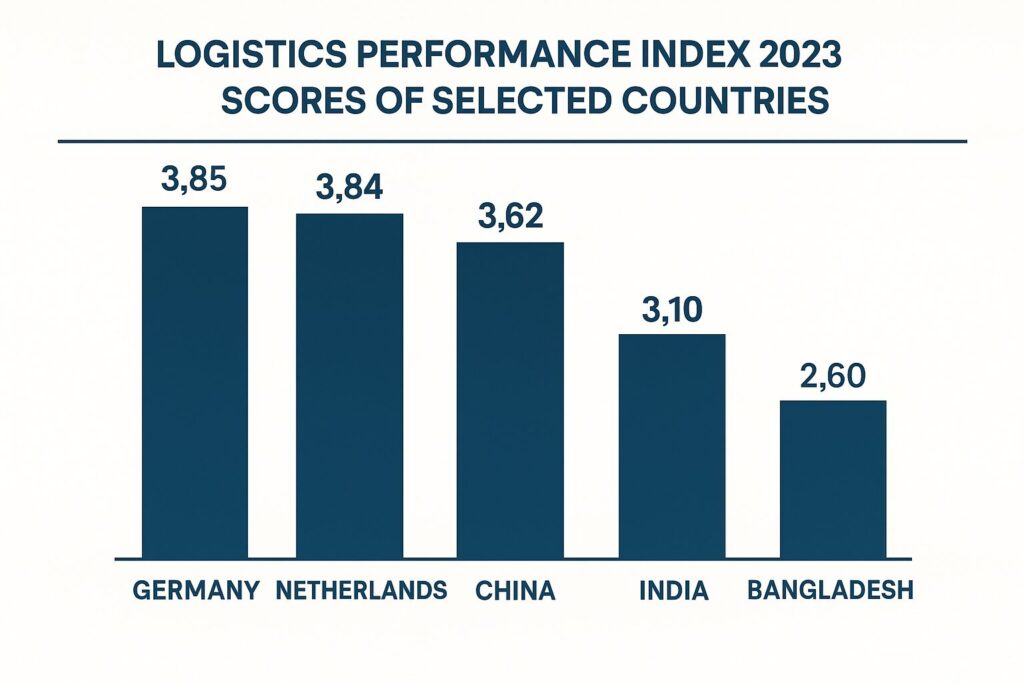
5) The reliability story: visibility + process reform
Visibility reduces buffers. NLP’s ULIP brings together railways, highways, ports, shipping, civil aviation, and customs datasets via APIs, letting exporters and LSPs track cargo across modes and nodes. Paired with E-LogS, it also creates a feedback loop for systemic fixes (e.g., gate congestion, documentation anomalies, off-dock bottlenecks). Press Information Bureau+1
Meanwhile, Gati Shakti’s geospatial planning ensures that last-mile/first-mile links—ICDs, MMLPs (multi-modal logistics parks), port rail-sidings, and economic-zone connectors—are co-located and sequenced, squeezing out avoidable re-handling and detours that wreck consistency. The LPI 2023 uptick reflects these process and infrastructure effects. pmgatishakti.gov.in+1
6) State-level competition: why the LEADS map matters to exporters
LEADS ranks states/UTs by logistics ecosystem quality. For exporters, choosing a factory location or consolidation hub in an “Achiever” state can mean faster clearances, better first/last-mile roads, MMLP access, and predictable enforcement. Recent reports spotlight Gujarat, Karnataka, Maharashtra, Tamil Nadu, Delhi and others among top performers—overlaps with established export hubs are not accidental. The Economic Times+1
Implication: When bidding on international orders with tight SLAs, the origin state can be a genuine competitive variable, not just a tax and labour consideration.
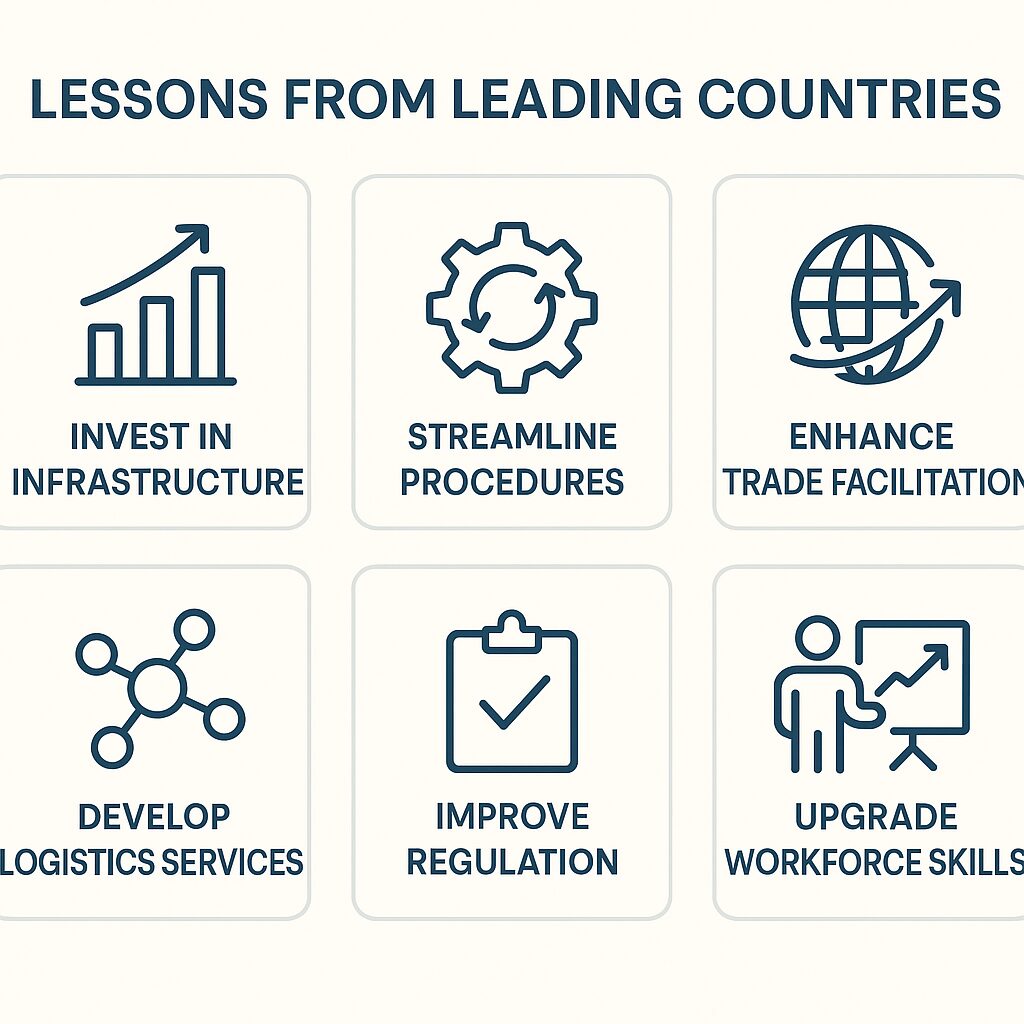
7) Sectoral impact pathways
Electronics and high-value manufacturing
- Need: Just-in-time inbound, low damage, tight export windows
- NLP lever: ULIP visibility, expressways to airports/seaports, DFC for bulk components, air cargo digitisation
- Edge gained: Lower buffer stocks, fewer premium air-freight switches, higher on-time performance
Auto & auto components
- Need: Multimodal options (rail/ro-ro/coastal), predictable vessel windows
- NLP lever: DFC + port productivity, coastal shipping gains under Sagarmala, faster gate-in/out
- Edge gained: Lower inland haulage cost; more reliable sequencing to overseas assembly plants Press Information Bureau
Pharma and perishables
- Need: Cold chain integrity, minimal dwell, regulatory predictability
- NLP lever: Airport cargo digitisation, port dwell-time reduction, ULIP data trails, CLPs for urban legs
- Edge gained: Reduced spoilage and demurrage; premium service credibility
Textiles & apparel
- Need: Frequent, smaller consignments; time-to-market
- NLP lever: ICD connectivity to ports, faster customs & documentation, state-level facilitation
- Edge gained: Shorter cycle from sampling to shipment; improved competitiveness vs. peers
8) International benchmarking—and India’s trajectory
Global buyers compare lead time and reliability, not just price. India’s LPI rank of 38 in 2023 places it ahead of several emerging peers (e.g., Indonesia) but behind top logistics performers. NLP sets an explicit ambition to reach Top-25 by 2030—a stretch that requires continued reductions in dwell times, standardised service levels, and wide ULIP adoption. lpi.worldbank.org+2lpi.worldbank.org+2
Ports: India’s improvements in turnaround and dwell are meaningful; nine Indian ports feature among the world’s top 100, and capacity additions continue. Sustaining this trend ensures that exporters can book windows with confidenceand reduce contingencies embedded in quotes. Press Information Bureau
Rail: As DFC sections hit full stride and first/last-mile links densify, exporters should see scheduled freight paths and assured transit times become a norm—critical to compete with East Asian benchmarks. The Economic Times
9) Urban freight and the “factory-to-gateway” problem
Exporters often lose days before cargo reaches the port/airport. NLP’s CLP guidelines push cities/states to adopt freight consolidation, off-peak deliveries, zoning, and digital permits, cutting urban friction that silently inflates export cycle times. Over time, CLPs integrated into state logistics policies can create predictable urban SLAs. Press Information Bureau
10) What still needs work (the candid view)
- First/last-mile to rail & ports – Many industrial clusters still lack affordable, high-quality connectors to rail sidings or waterways; missing links erode DFC benefits. NITI Aayog
- Trucking fragmentation & compliance costs – The long-tail of small fleet owners and uneven enforcement (overloading, toll leakages, parking scarcity) can re-introduce variability even when corridors are strong.
- Return-load economics – Imbalances in freight flows (e.g., bulk commodities one way) elevate empty-backhaul and raise effective costs for exporters on specific lanes. DFCCIL’s growth figures still show non-trivial empty trips. The Economic Times
- Project execution risks – Occasional rework or delays (e.g., reported WDFC pillars razed for realignment) remind us that last-mile commissioning and design integrity matter for confidence. The Times of India
- Data adoption & trust – ULIP’s promise depends on broad industry integration and data quality. MSMEs, who form the backbone of exports, need affordable connectors and hand-holding to benefit. TaxTMI
11) Sustainability and green logistics: a competitive differentiator
Global buyers increasingly price carbon and prefer suppliers with lower logistics emissions. India’s shift to DFC (electric traction), coastal shipping/inland waterways, and expressway-optimised trucking reduces intensity; states and the centre are also piloting EV freight and alternative fuels on key corridors. Gains in coastal and inland waterway cargo under Sagarmala further support greener mode share. For exporters selling into markets with CBAM-like regimes, greener logistics can be a sales enabler. Press Information Bureau
12) Exporter playbook: How to monetise the NLP gains now
- Integrate with ULIP via your LSP/TMS
- Get API-level status feeds to cut safety stock and compress order-to-cash. If your 3PL is not ULIP-enabled, ask why. Press Information Bureau
- Re-optimise origin nodes using LEADS
- When adding capacity, shortlist “Achiever” states or districts with strong CLP/State Logistics Policies. Better enforcement and infrastructure can shave days from cycle time. The Economic Times
- Shift suitable flows to rail/coastal
- Map SKU-lanes where service windows allow rail or coastal legs (DFC where possible). Lock scheduled slots with your rail operator or coastal line. The Economic Times
- Exploit port-side productivity
- Choose ports/terminals with low dwell and proven CPPI improvements (e.g., JNPA trajectory). Align truck arrival to gate-in windows to avoid queues and demurrage. India Shipping News+1
- Design for urban freight rules
- For metro-area factories/CFAs, plan off-peak dispatches, consolidation hubs, and digital permits to comply with CLPs and avoid fines or stoppages. Press Information Bureau
- Quote with confidence
- As corridor times standardise, tighten delivery promises in tenders; use data to back service levels. Your competitor might still be padding buffers.
- Green your lanes
- For EU/UK buyers, document mode shifts and cargo emissions improvements as part of ESG reporting and negotiations.
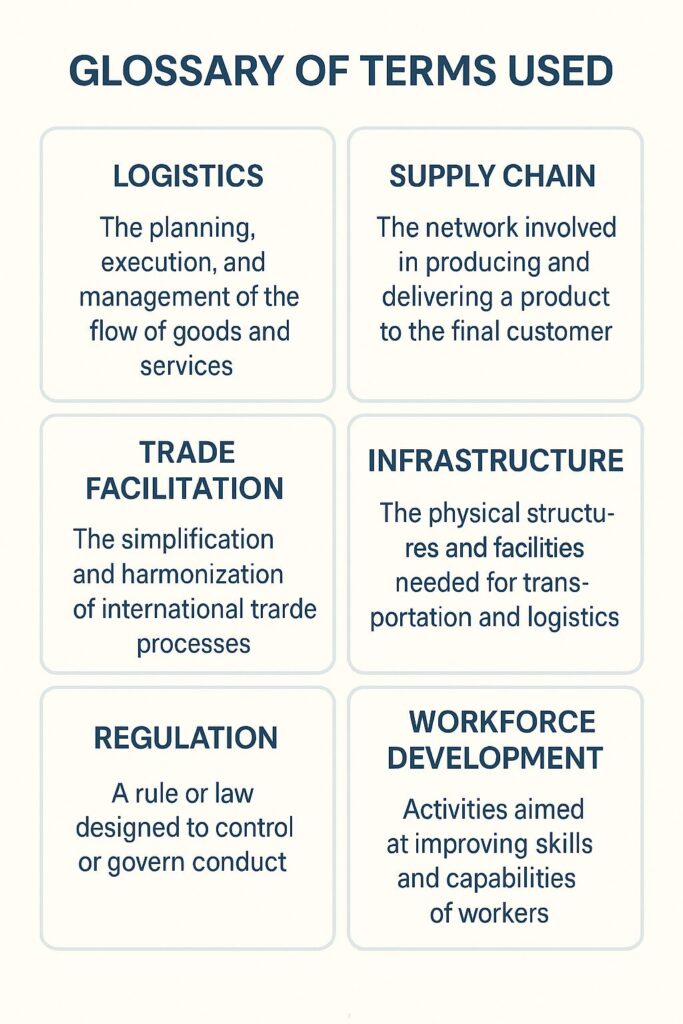
13) Policy to-do list to maximise export competitiveness
- Finish the last 10% of connectivity that yields 50% of the gains – Sidings, ICD links, and port road/rail connectors have out-sized returns. pmgatishakti.gov.in
- Institutionalise service-level agreements (SLAs) – Publishing corridor-wise assured transit times (especially on DFC-linked lanes) will unlock contractual innovation in freight services. The Economic Times
- Scale ULIP adoption among MSMEs – Subsidise connectors, provide sandbox kits, and promote plug-and-play via ERP/TMS vendors to democratise visibility. Press Information Bureau
- Standardise urban freight rules – Harmonise CLP playbooks across Tier-1/2/3 cities to reduce compliance variability for exporters running pan-India. Press Information Bureau
- Deepen coastal & IWT incentives – Continue to de-risk modal shifts with predictable schedules, last-mile trucking support, and trans-shipment infrastructure. Press Information Bureau
- Maintain port competition & transparency – Public dashboards for dwell, gate queues, and berth productivity help shippers choose best-in-class and push laggards to improve. Deccan Chronicle
14) What to watch in 2025–27
- DFC ramp-up & scheduled freight products on Western/Eastern corridors
- MMLP commissioning on priority nodes and their actual first/last-mile performance
- ULIP ecosystem metrics – active industry integrations, API traffic, new datasets onboarded Press Information Bureau
- Port-side SLAs – sustained low dwell at JNPA and other gateways; CPPI movements India Shipping News
- Updated LEADS editions and State Logistics Policies reflecting CLP adoption Press Information Bureau
- Official logistics cost updates under the new framework; sub-sector breakouts (MSME vs. large, perishable vs. durable) master-dpiit.digifootprint.gov.in
15) Risks and mitigation for exporters
- Execution slippage – Hedge by multi-port strategies, dual-routing (road vs. rail), and contracts with service credits. The Times of India
- Commodity cycle & freight volatility – Use ULIP-enabled data to re-price lanes proactively and renegotiate FSCs (fuel surcharges). Press Information Bureau
- Urban disruptions – Build CLP-compliant dispatch plans, maintain buffer CFAs just outside restricted zones. Press Information Bureau
16) Conclusion: From policy to price, promise, and perception
The National Logistics Policy is not just an infrastructure story; it is a competitiveness strategy. The combination of credible cost measurement (~7.97% of GDP in FY2023-24), digital integration (ULIP, E-LogS), state-level competition (LEADS), and hard assets (DFC, expressways, ports) is steadily shifting India’s export equation on price, predictability, and perception. master-dpiit.digifootprint.gov.in+2Press Information Bureau+2
For exporters, the play is immediate and tactical—plug into the data, exploit the corridors, choose high-performing origin nodes, and re-contract for tighter SLAs. For policymakers, the imperative is to finish the last-mile, scale adoption, and lock in service standards. Do these, and India’s NLP will not just lower a national percentage—it will win orders.
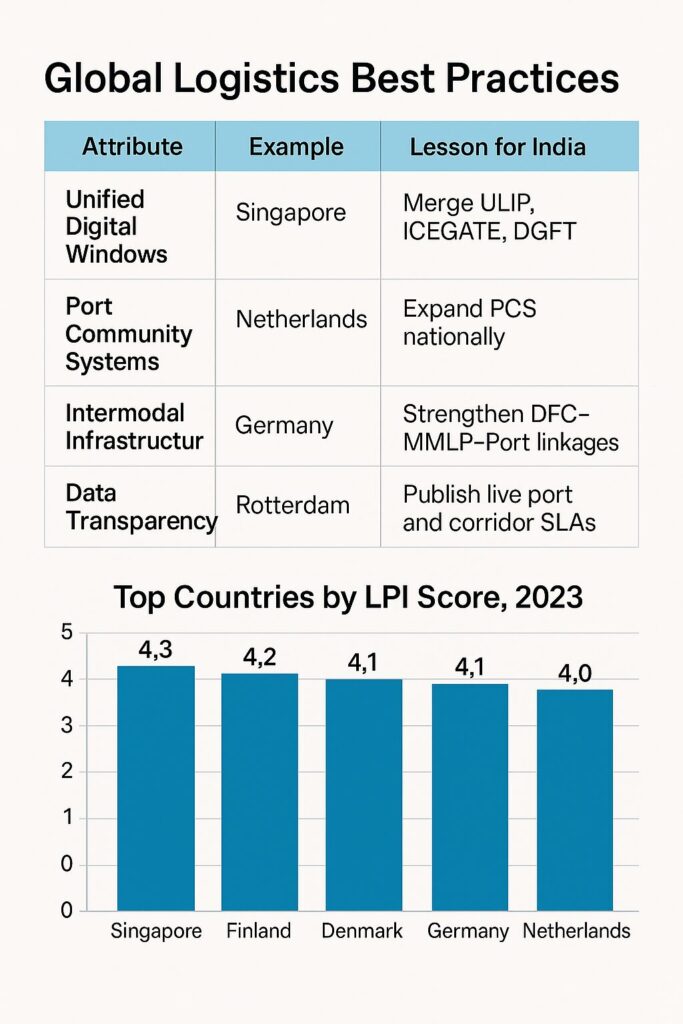
17) Glossary of terms used
NLP (National Logistics Policy): India’s 2022 policy framework to reduce logistics costs and improve service quality through digital integration, regulatory reforms, and state-level competition.
PM Gati Shakti (National Master Plan): A geospatial, cross-ministerial program that co-plans “hard” infrastructure (roads, rail, ports, airports, logistics parks) to deliver seamless multimodal connectivity.
ULIP (Unified Logistics Interface Platform): Government API “gateway” that stitches together data from multiple ministries so shippers/LSPs can track cargo, verify documents, and optimise routes.
E-LogS (Ease of Logistics Services): A B2G portal where industry can flag logistics bottlenecks for time-bound resolution.
LEADS (Logistics Ease Across Different States): Annual ranking and diagnostic of state logistics ecosystems to spur competition and targeted reforms.
CLP (City Logistics Plan): A city-level freight blueprint (time-windowing, consolidation, digital permits, zoning) that decongests urban legs of supply chains.
DFC / DFCCIL (Dedicated Freight Corridors / DFCCIL): High-capacity, freight-only rail corridors (Western/Eastern) operated by DFCCIL to provide faster, scheduled paths for cargo.
ICD / CFS (Inland Container Depot / Container Freight Station): Inland hub (ICD) or near-port facility (CFS) for customs, consolidation, stuffing/de-stuffing, and value-added logistics.
MMLP (Multi-Modal Logistics Park): A large, integrated node with rail/road interfaces, warehousing, value-add services, and often customs and cold-chain capability.
PCS (Port Community System): A neutral, shared digital platform connecting port stakeholders (terminals, customs, shipping lines, truckers, rail, forwarders) to exchange data in real time.
Single Window / NSW: One-stop digital entry point for all trade and border-management filings (permits, customs, standards).
NTP / TradeNet (Singapore): Singapore’s Networked Trade Platform (NTP) is the modern successor to TradeNet (1989), one of the world’s earliest and most influential national single windows. WCO News+2UNESCAP+2
Portbase (Netherlands): The Dutch PCS serving Rotterdam/Amsterdam—publicly owned, industry-operated—provides unified port data and process orchestration. World Bank+1
GVZ / Freight Village (Germany): Co-located clusters where logistics firms, terminals, and value-add services share intermodal infrastructure to lower costs and emissions. Deutsche GVZ-Gesellschaft mbH+1
uTradeHub (Korea): Korea’s paperless trade platform connecting customs, banks, logistics firms, and government agencies via a single secure interface. uncitral.un.org+1
LPI (Logistics Performance Index): World Bank index benchmarking countries on customs, infrastructure, shipments, competence, tracking, and timeliness; 2023 added empirical “speed of trade” measures. lpi.worldbank.org+1
CPPI (Container Port Performance Index): World Bank/S&P metric of port efficiency (used here to reinforce port-side competitiveness).
Dwell time / Turnaround time: Hours/days cargo or vessels spend within a node (port/terminal) before clearance or departure—critical drivers of lead time and working capital.
SLA (Service Level Agreement): Contracted, measurable logistics performance (e.g., transit time, dwell, on-time gate-in/out).
Just-in-Time (JIT): Lean supply approach that minimises inventory buffers by relying on predictable, visible logistics.
CBAM: Carbon Border Adjustment Mechanism; exporters into such markets benefit from greener, lower-emissions logistics.
18) How leading countries built top logistics performance—and lessons for India
The World Bank’s 2023 LPI highlights that top performers combine fast, predictable border processes with high-quality infrastructure and granular shipment visibility. India’s NLP is directionally aligned; the playbook below distils what the leaders did and how to translate it for India’s context. lpi.worldbank.org+1
Singapore: Single-window discipline, whole-of-ecosystem integration
What they did
- Pioneered TradeNet (1989) as a truly national single window; later evolved to the Networked Trade Platform (NTP) that connects traders’ ERPs, logistics systems, and last-mile services—reducing forms, handoffs, and error rates. WCO News+1
- Centralised and continuously updated rulebooks across agencies, so policy change propagates instantly to digital workflows. UNECE
Why it worked
- A stable, standards-driven data spine made private innovation easy (forwarders, platforms, fintech).
- The ecosystem view (government + industry) ensured that visibility and compliance sat in the same pane of glass.
Lessons for India
- Take ULIP beyond data access into workflow orchestration (permits, clearances, payments) so exporters don’t straddle multiple portals.
- Maintain a single, canonical rules engine so when regulations change, they update once—and instantly reflect across every connected system. WCO News
Netherlands (Rotterdam/Amsterdam): Port community systems and data-first ports
What they did
- Built Portbase, a neutral PCS owned by the public port authorities but run with industry discipline—standardising messages, APIs, and milestones across the port call, customs, trucking, and rail legs. World Bank+1
- Drove real-time port call digitalisation (planning, berth windows, tug/pilot scheduling) to shrink uncertainty and idle time. SAGE Journals
Why it worked
- Shared situational awareness enabled precise truck/rail arrival times, fewer queues, and lower dwell—directly improving schedule reliability for shippers.
Lessons for India
- Empower and scale Indian PCS footprints (public-interest governance, open specs). Publish live dwell/gate-queue dashboards to create user pressure for continuous improvement—mirroring Rotterdam’s data transparency ethos. World Bank
Germany: Freight-village networks and intermodal habit-forming
What they did
- Established GVZ (freight villages)—co-located distribution, rail terminals, and value-add services—to normalise road↔rail/IWT transfers and cut urban trucking. Deutsche GVZ-Gesellschaft mbH+1
- Flagship sites like Bremen GVZ anchored long-run competitiveness and attracted 3PL/4PL investment. wfb-bremen.de
Why it worked
- Clustering created scale economics, reliable intermodal options, and greener lanes—giving shippers credible rail/coastal alternatives.
Lessons for India
- Ensure MMLPs truly replicate GVZ DNA: rail sidings inside the fence, truck parking, 24×7 gates, bonded services, and on-site value-add operations—not just big warehouses along a highway.
- Incentivise scheduled rail products from MMLPs into DFC paths; standardise SLAs so exporters can contract to time, not just price. Deutsche GVZ-Gesellschaft mbH
South Korea: Paperless trade across customs, banking, and logistics
What they did
- Built uTradeHub, a paperless trade platform that integrates customs, port/air terminals, banks, insurers, and forwarders; includes a trusted trade-document repository and secure relay. uncitral.un.org+1
Why it worked
- Collapsing trade + finance + logistics into one secure workflow slashed exceptions and sped up working-capital cycles.
Lessons for India
- Extend ULIP/E-LogS rails to trade finance (digital BLs, e-invoicing, bank interfaces) so MSME exporters can turn documents into cash faster, cutting their cost of capital.
- Adopt a trusted trade document store with auditable chain-of-custody, interoperable with DGFT/ICEGATE.
“What the top LPI countries have in common”
- One front door for all cross-border formalities (single window) that keeps pace with changing rules. (Singapore; Korea.) WCO News+1
- Community systems at ports/airports that make time visible and measurable. (Netherlands.) World Bank
- Intermodal habit via designed hubs—not ad-hoc modal shifts. (Germany.) Deutsche GVZ-Gesellschaft mbH
- Public digital infrastructure + private innovation: government sets standards and neutral platforms; the market builds services on top. (All of the above.)
- Relentless KPI transparency—dwell, appointment adherence, terminal productivity—published and compared. (Rotterdam, others.) World Bank
19) One-Page Policy Brief: Enhancing Export Competitiveness through the NLP
Objective:
To transform India’s logistics ecosystem into a global benchmark, cutting costs, improving reliability, and fostering green and digital trade.
| Strategic Pillar | Current Status | Next Actions | Export Impact |
| Cost Reduction | 7.97% of GDP | Integrate DFC & MMLPs | Improve landed price |
| Digital Integration | ULIP live with 125+ APIs | Connect DGFT, RBI, and Customs | Reduce delays |
| Infrastructure | Gati Shakti mapping 16 ministries | Prioritise last-mile links | Faster door-to-port |
| State Reforms | LEADS benchmarking in place | State CLP rollout | Predictable logistics |
| Sustainability | EV freight pilots | Scale coastal/IWT | Meet carbon standards |
| MSME Empowerment | ULIP connectors costly | Subsidize integration kits | Broaden export base |
20) References & sources (selected)
- Press Information Bureau (PIB) – NLP launch & updates; E-LogS; CLPs; Sagarmala progress: Press Information Bureau+3Press Information Bureau+3Press Information Bureau+3
- PM Gati Shakti official portals & India.gov.in spotlights: pmgatishakti.gov.in+1
- DPIIT/NCAER logistics cost framework (2025): master-dpiit.digifootprint.gov.in
- Media coverage of the framework and ministerial guidance on cost trajectory: The Economic Times+1
- World Bank, LPI 2023: lpi.worldbank.org+1
- LEADS (Logistics Ease Across Different States): Press Information Bureau+2The Economic Times+2
- ULIP adoption & API ecosystem: Press Information Bureau+1
- DFC operationalisation & impact: The Economic Times+2DFCCIL+2
- Port performance/dwell & JNPA metrics: Deccan Chronicle+2ETInfra.com+2
